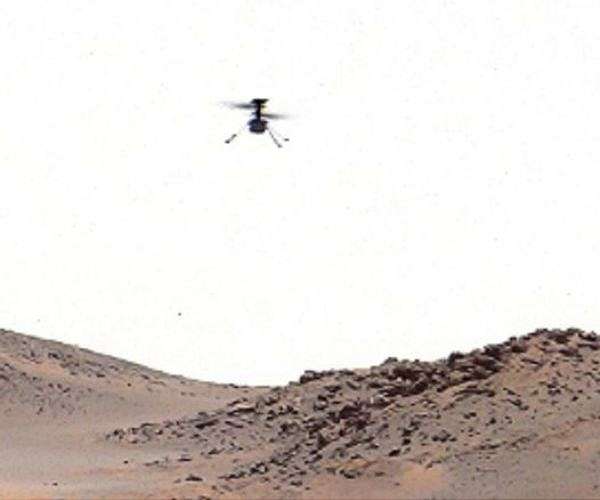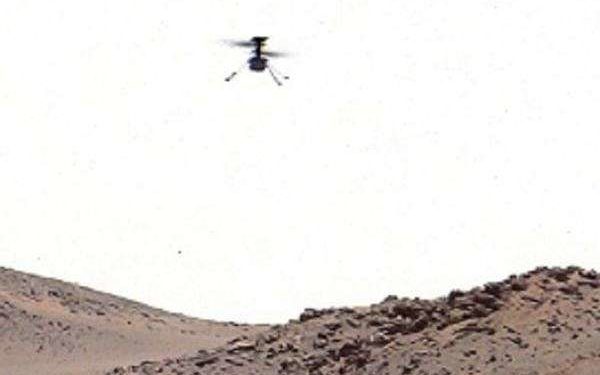
As Ingenuity’s mission ends a news era in flight on other planets and moons begins
by Kevin Olsen | UKSA Mars Fellow – University of Oxford
Oxford UK (SPX) Feb 01, 2024
It is difficult to emphasise the significance of the milestone surpassed by Nasa’s Mars helicopter, Ingenuity.
The little (1.8kg) helicopter touched down with the Perseverance rover in 2021. On 25 January, Nasa announced that the flying vehicle had to perform an emergency landing which damaged one of its rotors and ended its mission.
This reminds us that space exploration is still difficult to do. But Ingenuity’s three years on Mars proved that powered, controlled flight on Mars was possible.
The little helicopter lasted for far longer than had been planned and flew higher and further than many had envisaged. Beyond this Martian experiment, the rotorcraft’s success paves the way for other missions using flying vehicles to explore planets and moons.
The first landings on the Moon were static. The year 1969 was probably the most important one for space exploration, when Apollo 11 and Apollo 12 brought astronauts to the lunar surface, but 1970 was the year for planetary exploration.
In 1970, we had the first soft landing on another planet, Venus. The first robotic sample delivered to Earth from the Moon. And the first robot rover to drive around another body (also the Moon).
Since then, following over 50 years of planetary exploration and technology development, there have only been a small number of successful surface missions, and even fewer were able to move. Venus was visited by a dozen static landers between 1970 and 1985, and never again.
From rovers to helicopters
Mars was only successfully landed on three times between 1971 and 1976 before the Pathfinder lander and Sojourner rover arrived in 1997. The European Huygens spacecraft then landed on Titan, the moon of Saturn, in 2005.
These attempts at reaching the surface are rare, extremely difficult, and, historically, the landers were hardly ever mobile. Yet the Nasa Mars rovers Spirit, Opportunity, Curiosity, and Perseverance have all exceeded their designs and travelled further and further.
And Ingenuity flew.
It wasn’t the first spacecraft to fly. Those would be the balloons deployed by the Soviet Vega 1 and 2 missions, which floated over Venus in 1985. But Ingenuity had control, cameras, and connectivity. It took photos of its rover and of Mars from an entirely new perspective. It commanded the world’s attention and captured our hearts.
In Moscow, I had the chance to see models and replicas of the Vega balloons and the first lunar rover. They made a stronger impression on me than the Mars rover twins being used at Nasa’s Jet Propulsion Laboratory (JPL) in California. The Soviet missions were more audacious and different, and they were from generations ago, before my time and long before my career as a planetary scientist.
Ingenuity was audacious, original and completely new. The photos it took, of Perseverance, finding technology discarded from the descent module that carried it down to Mars and of the Martian vistas from a bird’s eye view, were breathtaking. Meanwhile, Perseverance also took videos of Ingenuity flying in the air. Nothing like it had ever seen before.
Future flights
Ingenuity had a rough ride getting there, however. The entire Mars 2020 mission (of Perseverance, Ingenuity and their transport systems) was sudden.
Following Nasa’s withdrawal from the joint European Space Agency ExoMars programme, which included a Mars rover mission, the US space agency started developing one on its own. This rover, later named Perseverance, went from announcement to concept to development and launch in just seven-and-a-half years.
And Ingenuity wasn’t included onboard at first. As an idea, it was proposed late in the development phase of Mars 2020, and faced serious opposition. It added extra complexity, cost, risk and new failure modes. It was also driven by an engineering objective, with the possibility of a little outreach – the opportunity to communicate the mission’s science and engineering to the public – on the side.
Ingenuity wasn’t intended to last for very long. It was designed to prove helicopter flight in the thin Mars atmosphere. It targeted five short flights over a month. Possible outcomes included hard landings, toppling over, losing power if its solar panels were covered in dust, or losing communication when it was far from the rover (this happened several times).
But it went way beyond expectations, surviving three years on the Martian surface, even through a dusty season, and making 72 flights. Much of its success was aided by the communication network that now exists at Mars.
Ingenuity receives instructions and transmits data to Perseverance, which communicates with a fleet of satellites that include the European ExoMars Trace Gas Orbiter, Nasa’s Maven spacecraft, and the Mars Reconnaissance Orbiter. These, in turn, communicate with two deep space networks on Earth, systems of radio antennas around the world that command and track spacecraft.
It took 50 years of planetary exploration to get here, but already we can see the impact on future exploration that Ingenuity’s mission is having. The next interplanetary rotorcraft will be the Dragonfly mission to Saturn’s moon Titan.
It will be a very different from Ingenuity. It will weigh about a ton and fly with eight rotors. It is a huge vehicle designed to fly in Titan’s thick atmosphere.
One of the next Red Planet missions will be Mars Sample Return, aiming to collect sample containers of Martian soil being prepared and cached by Perseverance. This has been planned to be carried out with use of a rover, but the success of Ingenuity has led to the idea – and now the development – of a helicopter to do that.
The future that Ingenuity has opened up for us is exciting. We’ll see helicopters on Mars and Venus, more balloons on Venus, swimming vehicles under the icy moons of Jupiter and Saturn, and maybe even an aeroplane or two.
Related Links
Department of Physics, University of Oxford
Mars News and Information at MarsDaily.com
Lunar Dreams and more
